Angular Dependence of the Ferromagnetic Resonance Parameters of [Ti/FeNi]6/Ti/Cu/Ti/[FeNi/Ti]6 Nanostructured Multilayered Elements in the Wide Frequency Range
Abstract
1. Introduction
2. Materials and Methods
3. Results and Discussion
4. Conclusions
Author Contributions
Funding
Acknowledgments
Conflicts of Interest
References
- Hernando, A.; Lopez-Dominguez, V.; Ricciardi, E.; Osiak, K.; Marin, P. Tuned scattering of electromagnetic waves by a finite length ferromagnetic microwire. IEEE Trans. Antennas Propag. 2016, 64, 1112–1115. [Google Scholar] [CrossRef]
- Semenov, S. Microwave tomography: Review of the progress towards clinical applications. Philos. Transact. A Math. Phys. Eng. Sci. 2009, 367, 3021–3042. [Google Scholar] [CrossRef] [PubMed]
- Ahsan, S.; Guo, Z.; Miao, Z.; Sotiriou, I.; Koutsoupidou, M.; Kallos, E.; Palikaras, G.; Kosmas, P. Design and experimental validation of a multiple-frequency microwave tomography system employing the DBIM-TwIST algorithm. Sensors 2018, 18, 3491. [Google Scholar] [CrossRef] [PubMed]
- Uchiyama, T.; Mohri, K.; Honkura, Y.; Panina, L.V. Recent advances of pico-Tesla resolution magneto-impedance sensor based on amorphous wire CMOS IC MI Sensor. IEEE Trans. Magn. 2012, 48, 3833–3839. [Google Scholar] [CrossRef]
- Kurlyandskaya, G.V.; Munoz, J.L.; Barandiaran, J.M.; Garca-Arribas, A.; Svalov, A.V.; Vas’kovskiy, V.O. Magnetoimpedance of sandwiched films: Experimental results and numerical calculations. J. Magn. Magn. Mater. 2002, 242–245, 291–293. [Google Scholar] [CrossRef]
- Gardner, D.S.; Schrom, G.; Paillet, F.; Jamieson, B.; Karnik, T.; Borkar, S. Review of on-chip inductor structures with magnetic films. IEEE Trans. Magn. 2009, 45, 4760–4766. [Google Scholar] [CrossRef]
- Agra, K.; Mori, T.J.A.; Dorneles, L.S.; Escobar, V.M.; Silva, U.C.; Chesman, C.; Bohn, F.; Corrêa, M.A. Dynamic magnetic behavior in non-magnetostrictive multilayered films grown on glass and flexible substrates. J. Magn. Magn. Mater. 2014, 355, 136–141. [Google Scholar] [CrossRef]
- Vas’kovskii, V.O.; Savin, P.A.; Volchkov, S.O.; Lepalovskii, V.N.; Bukreev, D.A.; Buchkevich, A.A. Nanostructuring effects in soft magnetic films and film elements with magnetic impedance. Techn. Phys. 2013, 58, 105–110. [Google Scholar]
- López Antón, R.A.; González, J.A.P.; Andrés, J.P.; Svalov, A.V.; Kurlyandskaya, G.V. Structural and magnetic properties of Ni0.8Fe0.2/Ti nanoscale multilayers. Nanomaterials 2018, 8, 780. [Google Scholar] [CrossRef]
- Kurlyandskaya, G.V.; Levit, V.I. Advanced materials for drug delivery and biosensors based on magnetic label detection. Mater. Sci. Eng. C 2007, 27, 495–503. [Google Scholar] [CrossRef]
- Beato-López, J.J.; Pérez-Landazábal, J.I.; Gómez-Polo, C. Magnetic nanoparticle detection method employing non-linear magnetoimpedance effects. J. Appl. Phys. 2017, 121, 163901. [Google Scholar] [CrossRef]
- Hudak, R.; Varga, R.; Hudak, J.; Praslicka, D.; Polacek, I.; Klein, P.; El Kammouni, R.; Vazquez, M. Influence of fixation on magnetic properties of glass-coated magnetic microwires for biomedical applications. IEEE Trans. Magn. 2015, 51, 5200104. [Google Scholar] [CrossRef]
- Kurlyandskaya, G.V.; Portnov, D.S.; Beketov, I.V.; Larrañaga, A.; Safronov, A.P.; Orue, I.; Medvedev, A.I.; Chlenova, A.A.; Sanchez-Ilarduya, M.B.; Martinez-Amesti, A.; et al. Nanostructured materials for magnetic biosensing. BBA Gen. Subj. 2017, 1861, 1494–1506. [Google Scholar] [CrossRef]
- Fernández, E.; Lopez, A.; Garcia-Arribas, A.; Svalov, A.V.; Kurlyandskaya, G.V.; Barrainkua, A. High-frequency magnetoimpedance response of thin-film microstructures using coplanar waveguides. IEEE Trans. Magn. 2015, 51, 6100404. [Google Scholar] [CrossRef]
- Makhotkin, V.E.; Shurukhin, B.P.; Lopatin, V.A.; Marchukov, P.Y.; Levin, Y.K. Magnetic field sensors based on amorphous ribbons. Sens. Act. A 1991, 27, 759–762. [Google Scholar] [CrossRef]
- Uchiyama, T.; Sompob, P.; Mohri, K.; Ishikawa, N. Nondestructive evaluation for structuring steel deformation using amorphous wire MI sensor. J. Magn. Soc. Jpn. 1999, 23, 1465–1468. [Google Scholar] [CrossRef]
- García-Chocano, V.M.; García-Miquel, H. DC and AC linear magnetic field sensor based on glass coated amorphous microwires with giant magnetoimpedance. J. Magn. Magn. Mater. 2015, 378, 485–492. [Google Scholar] [CrossRef]
- Kikuchi, H.; Shima, T.; Uetake, H.; Yabukami, S. Magneto-impedance of micromachined thin films less than 100 μm in length. IEEE Magn. Lett. 2016, 7, 6508105. [Google Scholar] [CrossRef]
- Kittel, C. Introduction to Solid State Physics; Wiley: New York, NY, USA, 1996. [Google Scholar]
- Bhagat, S.M. Metals Handbook, 9th ed.; American Society of Metals: Metals Park, OH, USA, 1986; Volume 10, p. 267. [Google Scholar]
- Kraus, L. The theoretical limits of giant magneto-impedance. J. Magn. Magn. Mater. 1999, 354, 167–196. [Google Scholar] [CrossRef]
- Antonov, A.S.; Gadetskii, S.N.; Granovsky, A.B.; D’yachkov, A.L.; Paramonov, V.P.; Perov, N.S.; Prokoshin, A.F.; Usov, N.A.; Lagar’kov, A.N. Giant magnetoimpedance in amorphous and nanocrystalline multilayers. Phys. Met. Metallogr. 1997, 83, 612–618. [Google Scholar]
- Kikuchi, H.; Umezaki, T.; Shima, T.; Sumida, S.; Oe, S. Impedance change ratio and sensitivity of micromachined single-layer thin film magneto-impedance sensor. IEEE Magn. Lett. 2019, 10, 8107205. [Google Scholar] [CrossRef]
- Fernandez, E.; Svalov, A.V.; García-Arribas, A.; Feuchtwanger, J.; Barandiaran, J.M.; Kurlyandskaya, G.V. High performance magnetoimpedance in FeNi/Ti nanostructured multilayers with opened magnetic flux. J. Nanosci. Nanotechnol. 2012, 12, 7496–7500. [Google Scholar] [CrossRef] [PubMed]
- Yelon, A.; Menard, D.; Britel, M.; Ciureanu, P. Calculations of giant magnetoimpedance and of ferromagnetic resonance response are rigorously equivalent. Appl. Phys. Lett. 1996, 69, 3084–3085. [Google Scholar] [CrossRef]
- Harrison, E.P.; Turney, G.L.; Rowe, H. Electrical properties of wires of high permeability. Nature 1935, 135, 961. [Google Scholar] [CrossRef]
- Gromov, A.; Korenivski, V.; Haviland, D.; van Dover, R.B. Analysis of current distribution in magnetic film inductors. J. Appl. Phys. 1999, 85, 5202–5204. [Google Scholar] [CrossRef]
- Barandiarán, J.M.; García-Arribas, A.; de Cos, D. Transition from quasistatic to ferromagnetic resonance regime in giant magnetoimpedance. J. Appl. Phys. 2006, 99, 103904. [Google Scholar] [CrossRef]
- Ménard, D.; Yelon, A. Theory of longitudinal magnetoimpedance in wires. J. Appl. Phys. 2000, 88, 379–393. [Google Scholar] [CrossRef]
- Shcherbinin, S.V.; Volchkov, S.O.; Lepalovskii, V.N.; Chlenova, A.A.; Kurlyandskaya, G.V. System based on a ZVA-67 Vector Network Analyzer for measuring high-frequency parameters of magnetic film structures, Rus. J. Nondestr. 2017, 53, 204–212. [Google Scholar] [CrossRef]
- Kurlyandskaya, G.V.; García-Arribas, A.; Fernández, E.; Svalov, A.V. Nanostructured magnetoimpedance multilayers. IEEE Trans. Magn. 2012, 48, 1375–1380. [Google Scholar] [CrossRef]
- Kurlyandskaya, G.V.; Elbaile, L.; Alves, F.; Ahamada, B.; Barrue, R.; Svalov, A.V.; Vas’kovskiy, V.O. Domain structure and magnetization process of a giant magnetoimpedance geometry FeNi/Cu/FeNi(Cu)FeNi/Cu/FeNi sensitive element J. Phys. Condens. Matter 2004, 16, 6561–6568. [Google Scholar] [CrossRef]
- Cheng, S.F.; Lubitz, P.; Zheng, Y.; Edelstein, A.S. Effects of spacer layer on growth, stress and magnetic properties of sputtered permalloy film. J. Magn. Magn. Mater. 2004, 282, 109–114. [Google Scholar] [CrossRef]
- Correa, M.A.; Bohn, F.; Viegas, A.D.C.; de Andrade, A.M.H.; Schelp, L.F.; Sommer R., L. Magnetoimpedance effect in structured multilayered amorphous thin films. J. Phys. D Appl. Phys. 2008, 41, 175003. [Google Scholar] [CrossRef]
- Svalov, A.V.; Fernandez, E.; Arribas, A.G.; Alonso, J.; Gubieda, M.L.F.; Kurlyandskaya, G.V. FeNi-based magnetoimpedance multilayers: Tailoring of the softness by magnetic spacers. Appl. Phys. Lett. 2012, 100, 162410. [Google Scholar] [CrossRef]
- Saito, N.; Fujiwara, H.; Sugita, V. A new type of magnetic domain structure in negative magnetostriction Ni-Fe films. J. Phys. Soc. Jpn. 1964, 19, 1116–1125. [Google Scholar] [CrossRef]
- Nishibe, Y.; Yamadera, H.; Ohta, N.; Tsukada, K.; Ohmura, Y. Magneto-impedance effect of a layered CoNbZr amorphous film formed on a polyimide substrate. IEEE Trans. Magn. 2003, 39, 571–575. [Google Scholar] [CrossRef]
- Rivero, M.A.; Maicas, M.; Lopez, E.; Aroca, C.; Sanchez, M.C.; Sanchez, P. Influence of the sensor shape on permalloy/Cu/permalloy magnetoimpedance. J. Magn. Magn. Mater. 2003, 254–255, 636–638. [Google Scholar] [CrossRef]
- Yabukami, S.; Kato, K.; Ohtomo, Y.; Ozawa, T.; Arai, K. A thin film magnetic field sensor of sub-pT resolution and magnetocardiogram (MCG) measurement at room temperature. J. Magn. Magn. Mater. 2009, 321, 675–678. [Google Scholar] [CrossRef]
- Corrêa, M.A.; Bohn, F.; da Silva, R.B.; Sommer, R.L. Magnetoimpedance effect at the high frequency range for the thin film geometry: Numerical calculation and experiment. J. Appl. Phys. 2014, 116, 243904. [Google Scholar] [CrossRef]
- Kurlyandskaya, G.V.; Svalov, A.V.; Fernández, E.; García-Arribas, A.; Barandiarán, J.M. FeNi-based magnetic layered nanostructures: Magnetic properties and giant magnetoimpedance. J. Appl. Phys. 2010, 107, 09C502. [Google Scholar] [CrossRef]
- Buznikov, N.A.; Safronov, A.P.; Orue, I.; Golubeva, E.V.; Lepalovskij, V.N.; Svalov, A.V.; Chlenova, A.A.; Kurlyandskaya, G.V. Modelling of magnetoimpedance response of thin film sensitive element in the presence of ferrogel: Next step toward development of biosensor for in tissue embedded magnetic nanoparticles detection. Bios. Bioelectr. 2018, 117, 366–372. [Google Scholar] [CrossRef]
- Nguyen, C. Analysis Methods for RF, Microwave, and Millimeter-Wave Planar Transmission Line Structures; John Wiley & Sons: Hoboken, NJ, USA, 2003. [Google Scholar]
- Shcherbinin, S.; Volchkov, V.; Svalov, A.; Kurlyandskaya, G. Microwave absorption of electromagnetic radiation in thin magnetic films and FeNi–based multilayered structures designed for applications. Mater. Methods Technol. J. Int. Sci. Publ. 2017, 11, 138–150. [Google Scholar]
- Pozar, D.M. Microwave Engineering. Wiley: Hoboken, NJ, USA, 2004. [Google Scholar]
- Shcherbinin, S.V.; Pérez, R.; Vazquez, M.; Kurlyandskaya, G.V. Ferromagnetic resonance in electroplated CuBe/FeCoNi and amorphous CoFeSiB wires Ferromagnetic resonance in electroplated CuBe/FeCoNi and amorphous CoFeSiB wires. IEEE Trans. Magn. 2020. [Google Scholar] [CrossRef]
- Stoner, E.C.; Wohlfarth, E.P. A mechanism of magnetic hysteresis in heterogeneous alloys. Philos. Trans. R. Soc. London, Ser. A 1948, 240, 599–642. [Google Scholar] [CrossRef]
- Gurevich, A.G.; Melkov, G.A. Magnetization Oscillations and Waves; CRC Press Inc.: Boca Raton, FL, USA, 1996. [Google Scholar]
- Stoner, E.C. The demagnetizing factors for ellipsoids. Phil. Mag. Ser. 7 1945, 36, 803–821. [Google Scholar] [CrossRef]
- Srinivasu, V.V.; Lofland, S.E.; Bhagat, S.M.; Ghosh, K.; Tyagi, S.D. Temperature and field dependence of microwave losses in manganite powders. J. Appl. Phys. 1999, 86, 1067–1072. [Google Scholar] [CrossRef]
- Buznikov, N.A. The effect of surface domain structure on low-field microwave absorption of magnetic microwires. J. Phys. D-Appl. Phys. 2010, 43, 055002. [Google Scholar] [CrossRef]
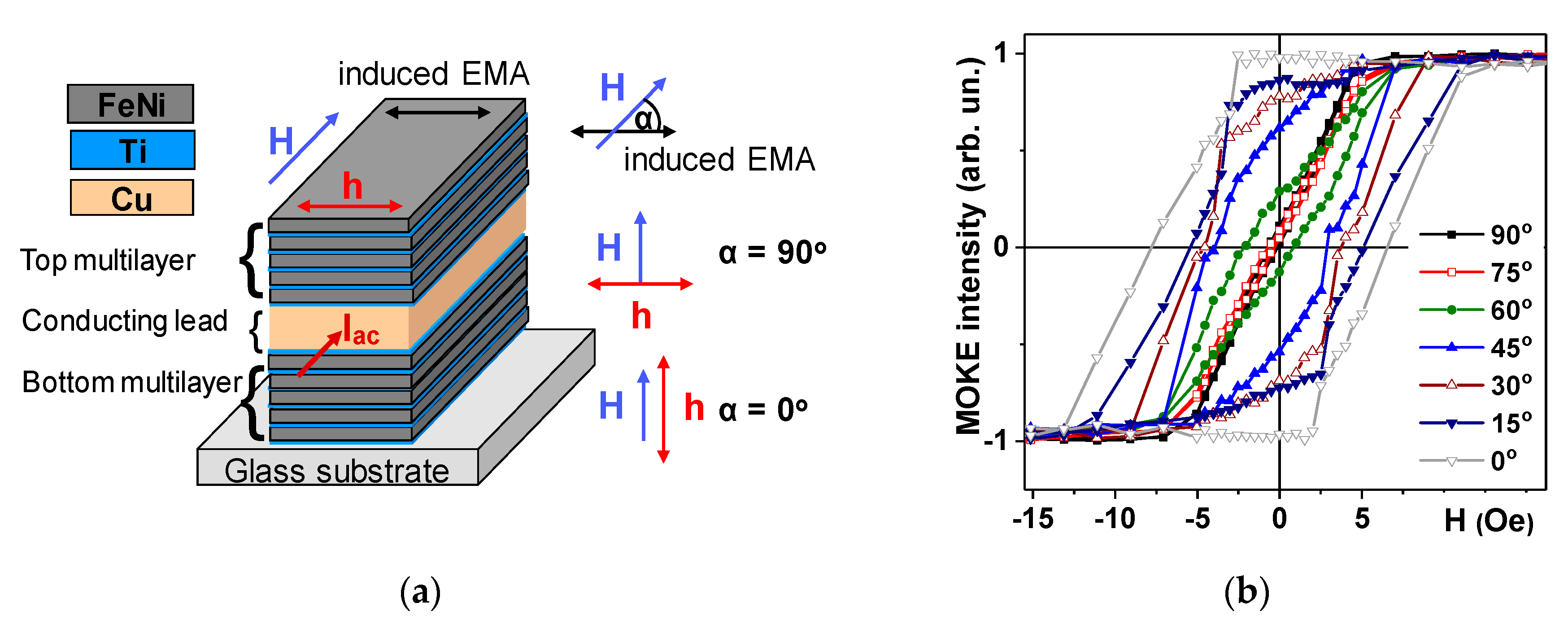
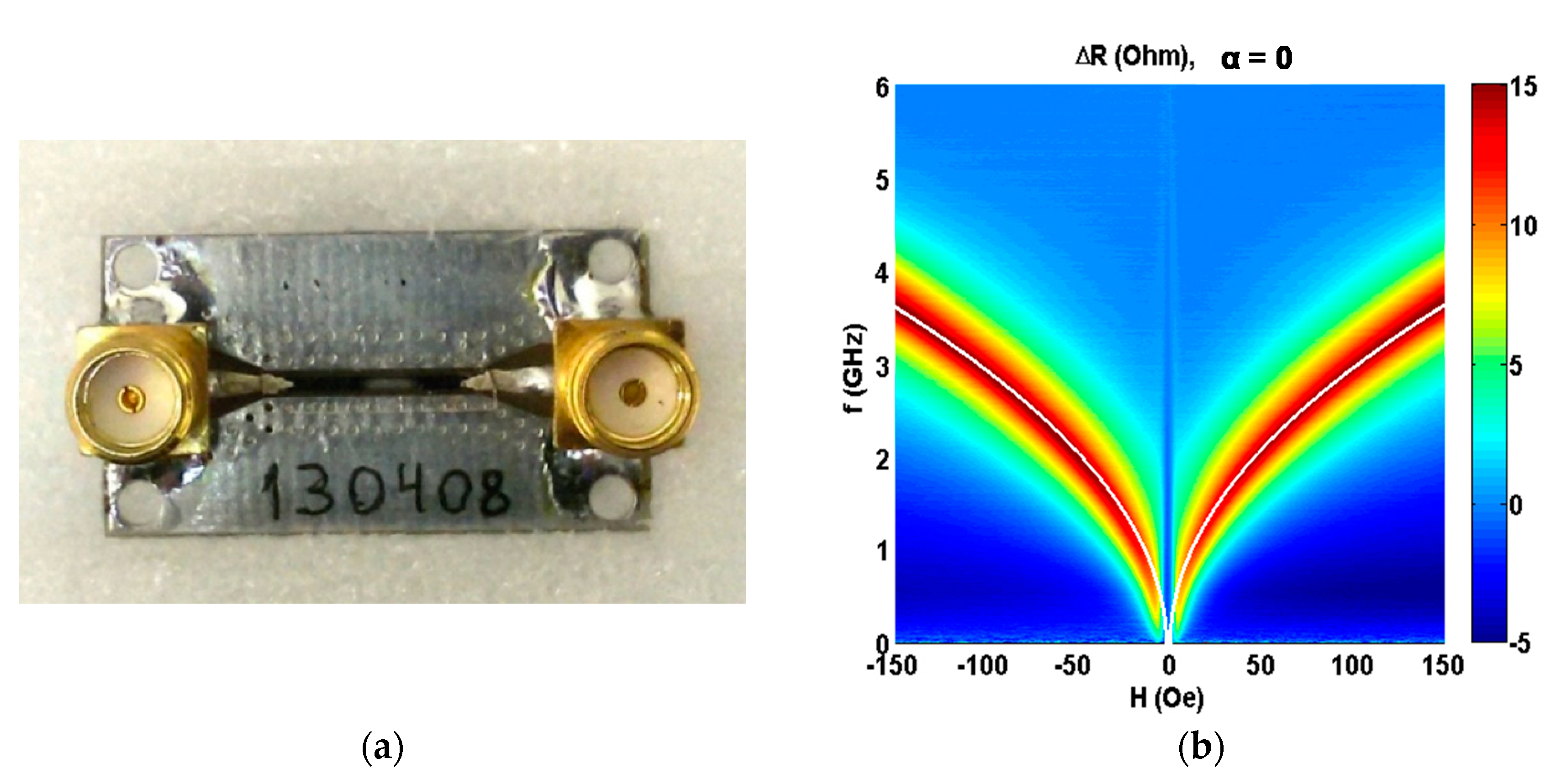
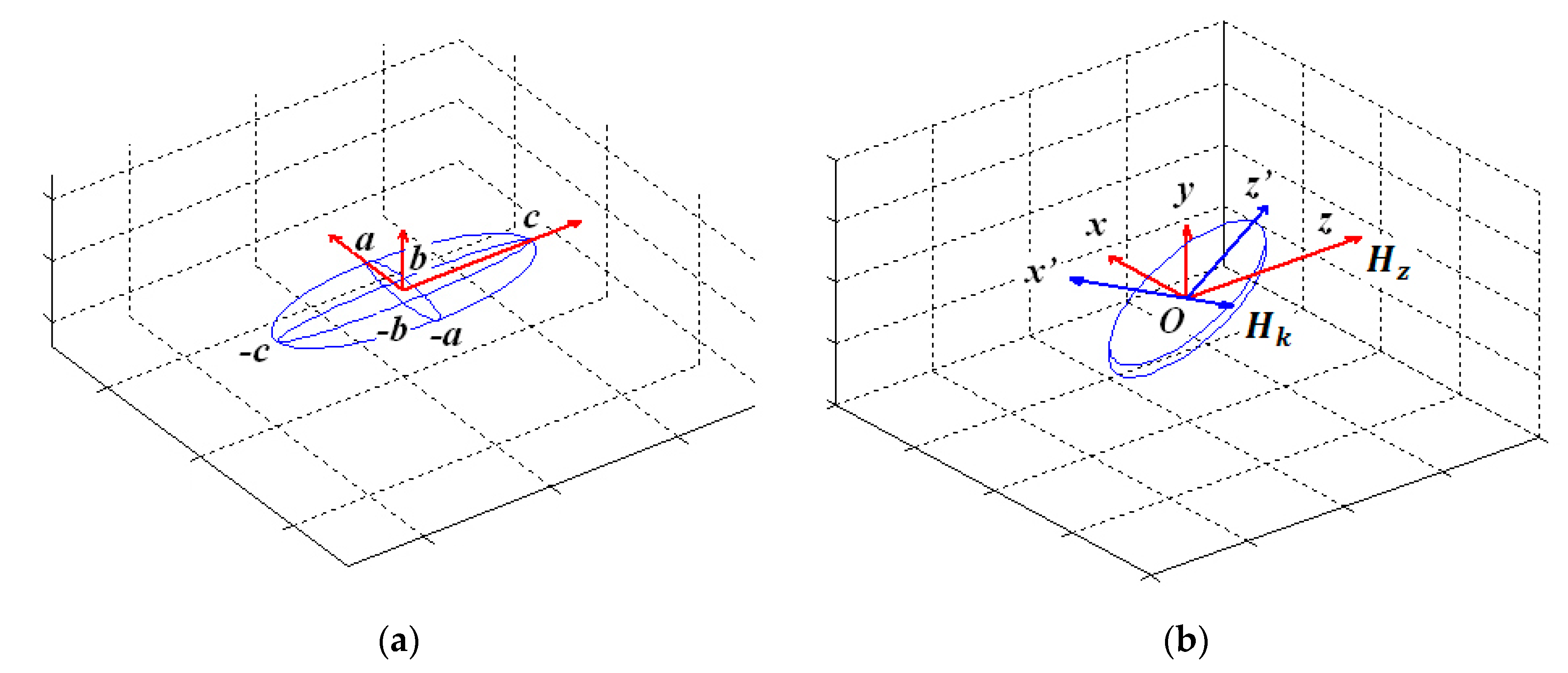
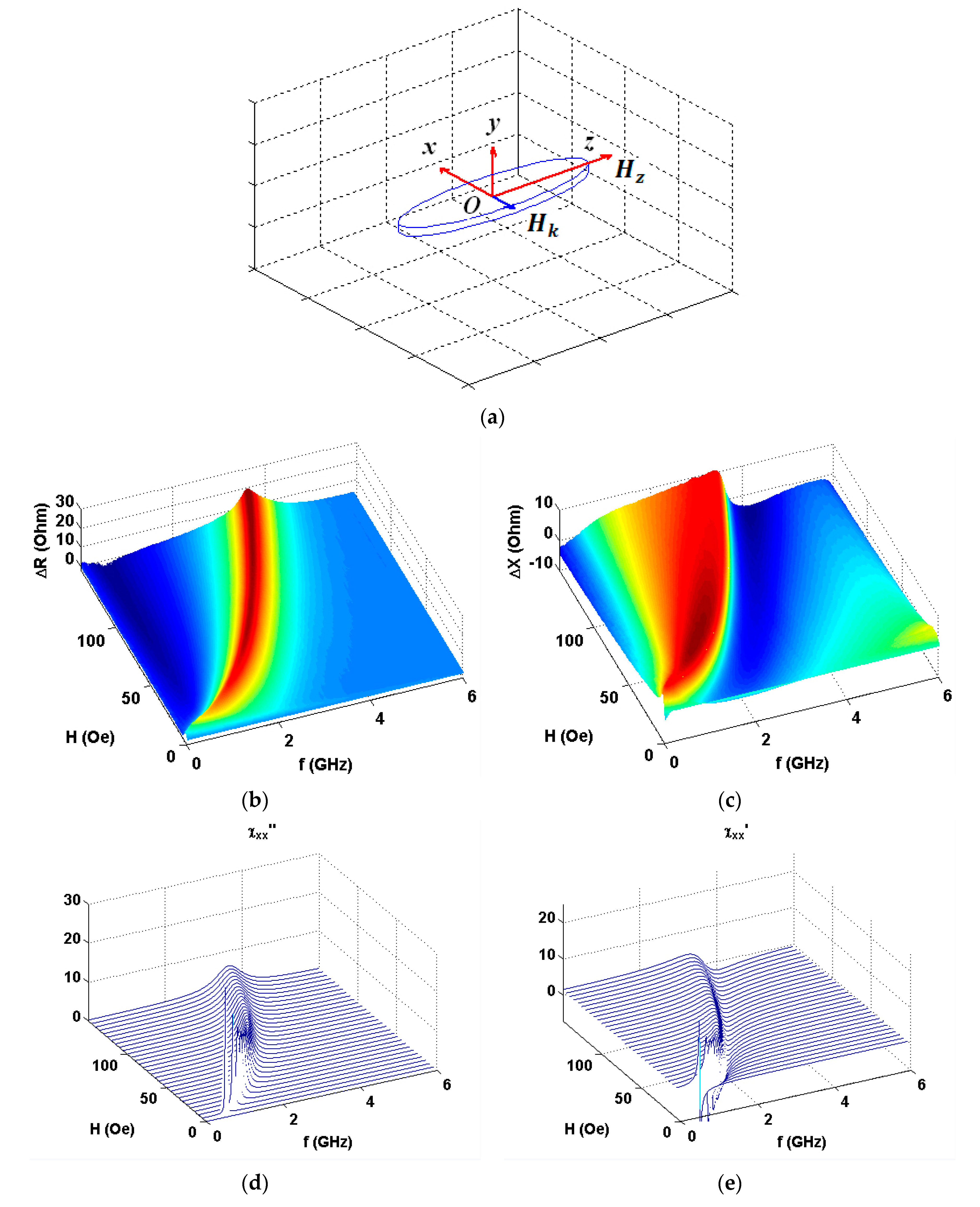
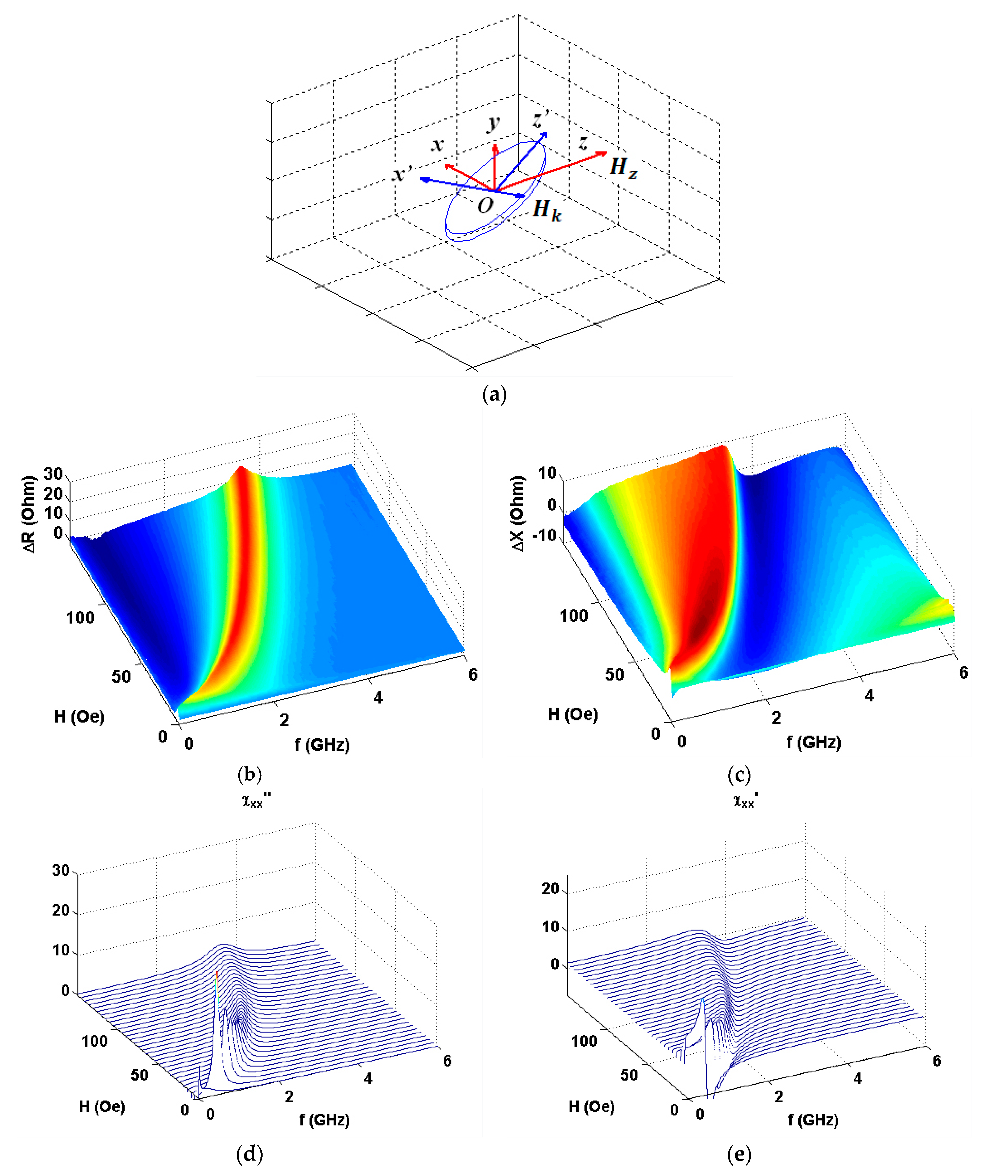
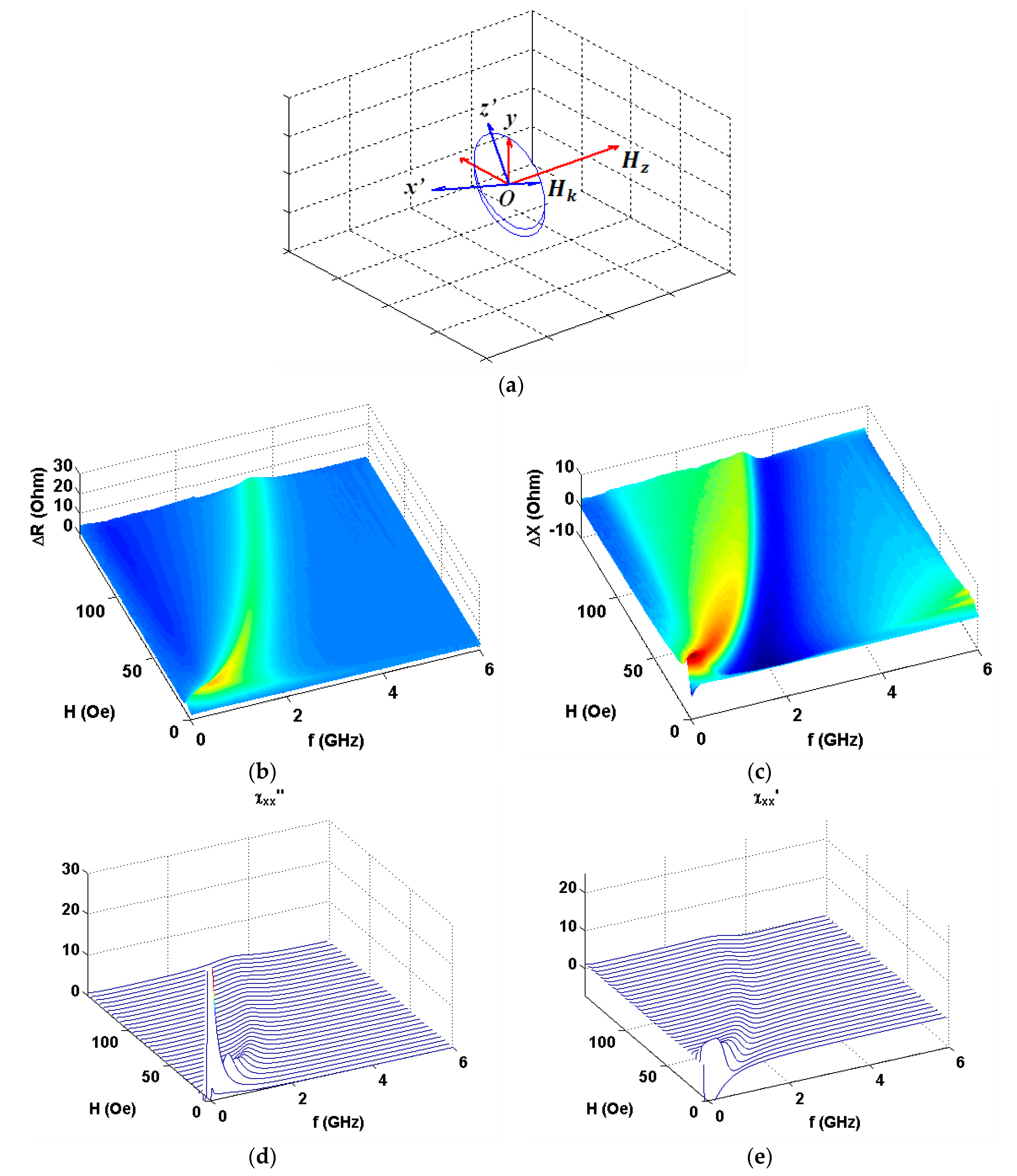
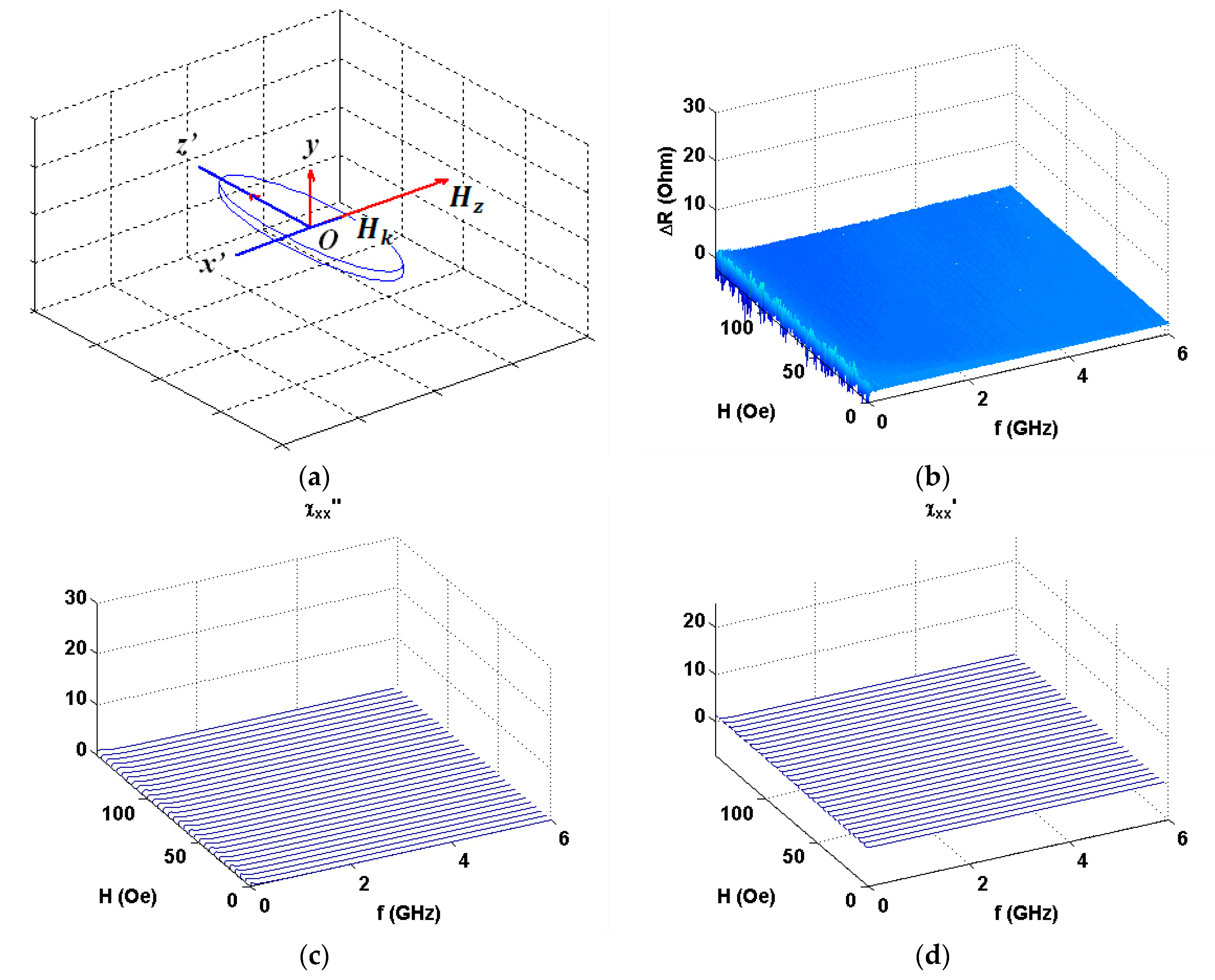
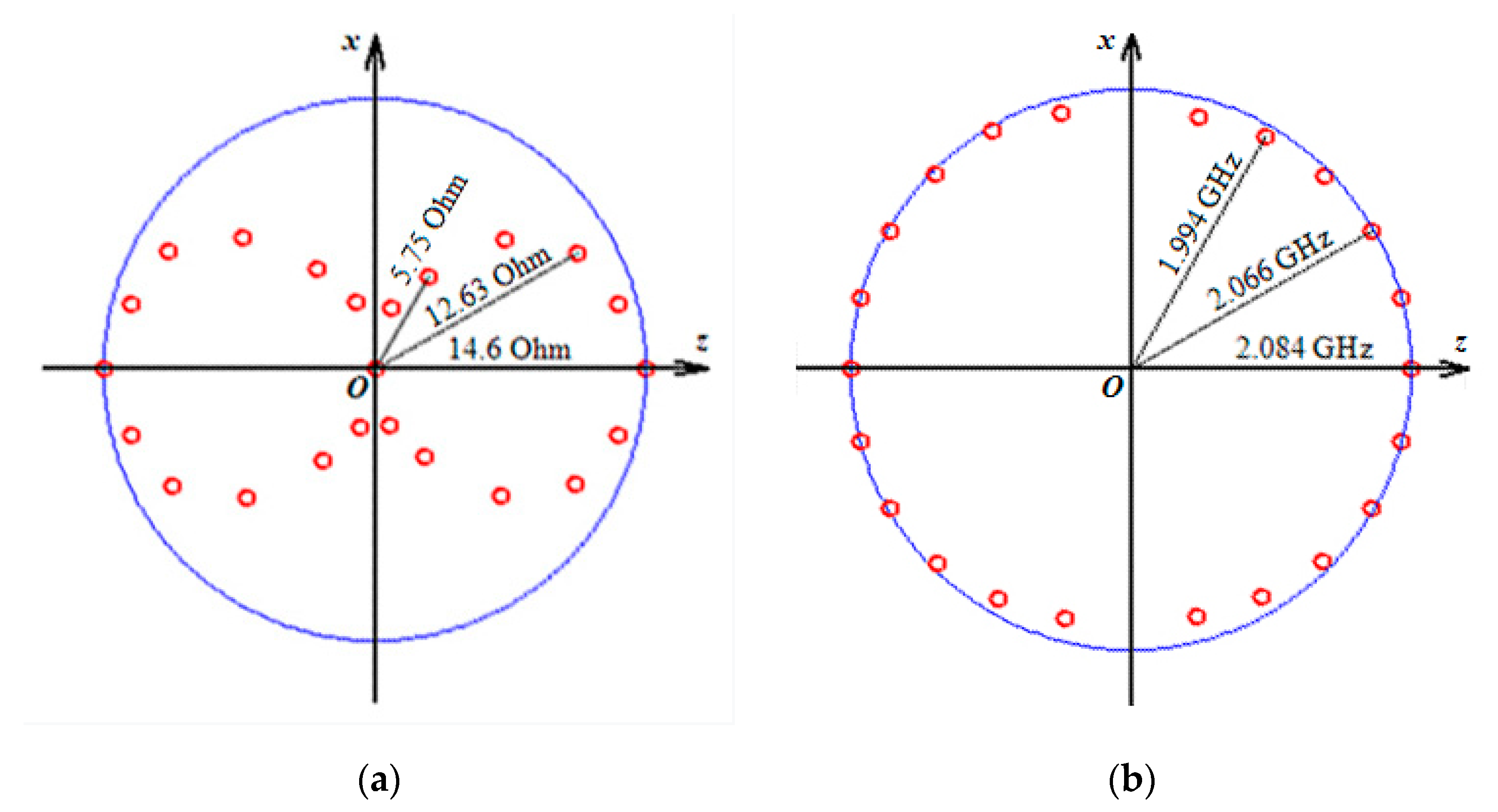
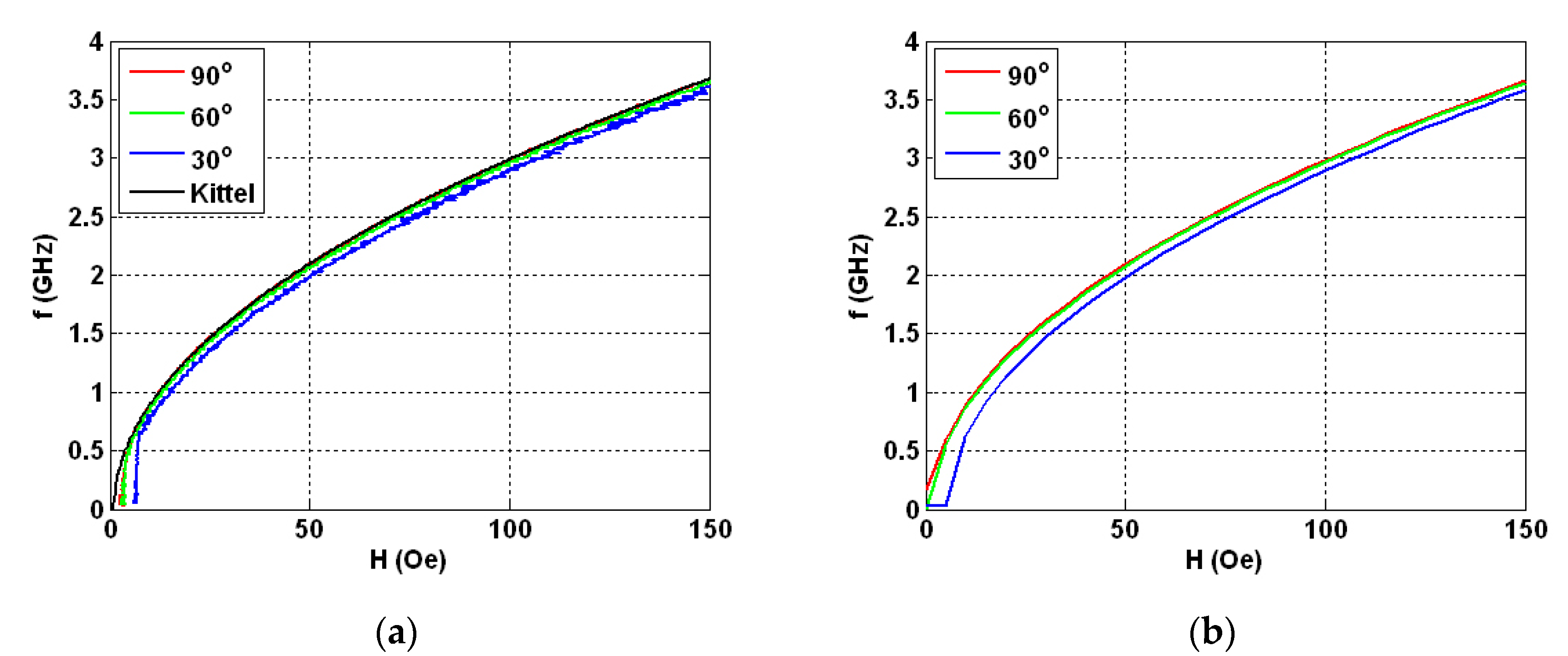
| Measured parameters | S11, S12, S21, S22 |
| Frequency range with Helmholtz coils | 0.02–6 GHz |
| Characteristic impedance | 50 Ohms |
| Microwave power | 0.1 mW |
| Magnetic field variation with Helmholtz coils | −150–150 Oe |
| Number of measurements for averaging | 5 |
| Angle for the Direction of the in-Plane Magnetic Field α, ° | Coercivity Hc, Oe | Anisotropy Field Hk, Oe |
|---|---|---|
| 90 | 0.0 | 5.5 |
| 75 | 0.0 | 5.7 |
| 60 | 1.5 | 6.8 |
| 45 | 3.5 | 7.0 |
| 30 | 4.2 | 8.6 |
| 15 | 5.3 | 11.0 |
| 0 | 7.1 | 11.5 |
© 2020 by the authors. Licensee MDPI, Basel, Switzerland. This article is an open access article distributed under the terms and conditions of the Creative Commons Attribution (CC BY) license (http://creativecommons.org/licenses/by/4.0/).
Share and Cite
Shcherbinin, S.V.; Svalov, A.V.; Melnikov, G.Y.; Kurlyandskaya, G.V. Angular Dependence of the Ferromagnetic Resonance Parameters of [Ti/FeNi]6/Ti/Cu/Ti/[FeNi/Ti]6 Nanostructured Multilayered Elements in the Wide Frequency Range. Nanomaterials 2020, 10, 433. https://doi.org/10.3390/nano10030433
Shcherbinin SV, Svalov AV, Melnikov GY, Kurlyandskaya GV. Angular Dependence of the Ferromagnetic Resonance Parameters of [Ti/FeNi]6/Ti/Cu/Ti/[FeNi/Ti]6 Nanostructured Multilayered Elements in the Wide Frequency Range. Nanomaterials. 2020; 10(3):433. https://doi.org/10.3390/nano10030433
Chicago/Turabian StyleShcherbinin, Sergei V., Andrey V. Svalov, Grigory Y. Melnikov, and Galina V. Kurlyandskaya. 2020. "Angular Dependence of the Ferromagnetic Resonance Parameters of [Ti/FeNi]6/Ti/Cu/Ti/[FeNi/Ti]6 Nanostructured Multilayered Elements in the Wide Frequency Range" Nanomaterials 10, no. 3: 433. https://doi.org/10.3390/nano10030433
APA StyleShcherbinin, S. V., Svalov, A. V., Melnikov, G. Y., & Kurlyandskaya, G. V. (2020). Angular Dependence of the Ferromagnetic Resonance Parameters of [Ti/FeNi]6/Ti/Cu/Ti/[FeNi/Ti]6 Nanostructured Multilayered Elements in the Wide Frequency Range. Nanomaterials, 10(3), 433. https://doi.org/10.3390/nano10030433






